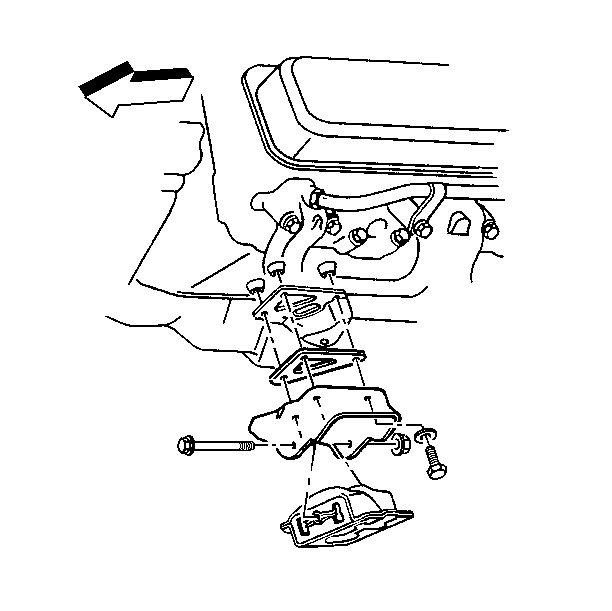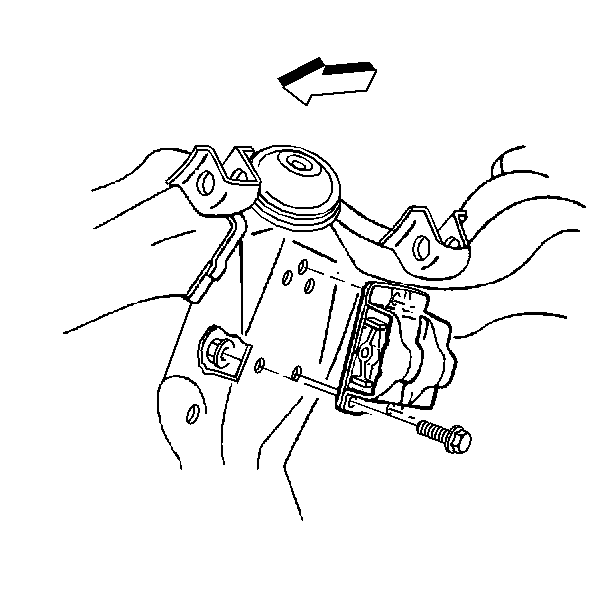Engine Mount Replacement Front Mount
Removal Procedure
- Support the engine with a suitable jack. Do not load the engine mounting.
- Raise the engine only enough in order to permit removal of the engine mounting.
- Remove the engine mounting through-bolt and nut.
- Remove the mounting assembly bolts, nuts, and washers.
- Remove the mounting assembly.
Notice: When supporting the engine to replace a mount, raise the engine only to the height required to provide clearance for mount removal. It may be necessary to drain the cooling system and disconnect hoses to avoid damage when the engine is raised. Be careful that control cables and wiring are not damaged from raising the engine. When replacing a single front mount, both mounts should be detached before attempting to raise the engine. Failure to do this will place excessive stress on the attached mount when the engine is raised.
Notice: Raise the engine to allow sufficient clearance. Distributor damage results from interference between the rear of the engine and the dash panel.


Installation Procedure
- Install the mounting assembly.
- Install the mounting assembly bolts, nuts, and washers.
- Install the engine mount through-bolt and nut. Lower the engine until the bolt can be inserted. Install the nut.

Tighten
| • | Tighten the bolts to 59 N·m (44 lb ft). |
| • | Tighten the nuts to 45 N·m (33 lb ft). |
Notice: Use the correct fastener in the correct location. Replacement fasteners must be the correct part number for that application. Fasteners requiring replacement or fasteners requiring the use of thread locking compound or sealant are identified in the service procedure. Do not use paints, lubricants, or corrosion inhibitors on fasteners or fastener joint surfaces unless specified. These coatings affect fastener torque and joint clamping force and may damage the fastener. Use the correct tightening sequence and specifications when installing fasteners in order to avoid damage to parts and systems.

Tighten
Tighten the through-bolt nut to 68 N·m (50 lb ft).
Engine Mount Replacement Rear Mount
Removal Procedure
- Support the rear of the engine to relieve the weight on the rear mount.
- Remove the mount to crossmember nuts and washers.
- Remove the mount to transmission bolts and washers.
- Raise the rear of the engine only enough to permit removal of the mount.
- Remove the mount.
Notice: When supporting the engine to replace a mount, raise the engine only to the height required to provide clearance for mount removal. It may be necessary to drain the cooling system and disconnect hoses to avoid damage when the engine is raised. Be careful that control cables and wiring are not damaged from raising the engine. When replacing a single front mount, both mounts should be detached before attempting to raise the engine. Failure to do this will place excessive stress on the attached mount when the engine is raised.

Installation Procedure
- Install the mount.
- Lower the rear of the engine.
- Install the mount to transmission bolts and washers.
- Install the mount to crossmember nuts and washers.

Tighten
Tighten the fasteners to specifications. Refer to
Fastener Tightening Specifications
.
Notice: Use the correct fastener in the correct location. Replacement fasteners must be the correct part number for that application. Fasteners requiring replacement or fasteners requiring the use of thread locking compound or sealant are identified in the service procedure. Do not use paints, lubricants, or corrosion inhibitors on fasteners or fastener joint surfaces unless specified. These coatings affect fastener torque and joint clamping force and may damage the fastener. Use the correct tightening sequence and specifications when installing fasteners in order to avoid damage to parts and systems.
